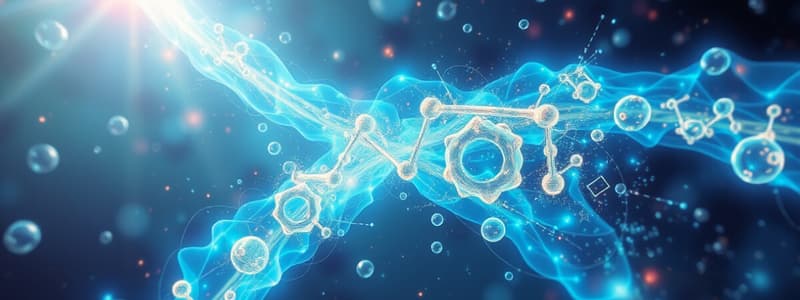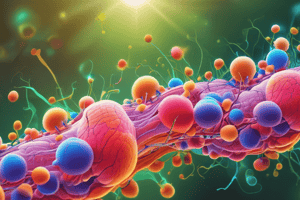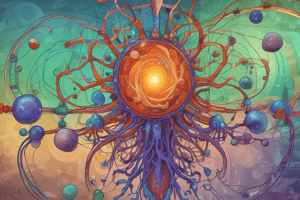Podcast
Questions and Answers
What is chemical energy primarily carried by in cells?
What is chemical energy primarily carried by in cells?
- ATP (correct)
- DNA
- ADP
- Glucose
What does ATP stand for?
What does ATP stand for?
Adenosine triphosphate
What happens to ATP when one of its phosphate groups is removed?
What happens to ATP when one of its phosphate groups is removed?
It becomes ADP and releases energy.
Chemosynthesis uses ______ energy instead of light energy.
Chemosynthesis uses ______ energy instead of light energy.
What are producers?
What are producers?
What process captures energy from sunlight to make sugars?
What process captures energy from sunlight to make sugars?
What is the function of chlorophyll?
What is the function of chlorophyll?
Where does photosynthesis take place in plants?
Where does photosynthesis take place in plants?
What are thylakoids?
What are thylakoids?
What is the stroma in a chloroplast?
What is the stroma in a chloroplast?
What are light-dependent reactions?
What are light-dependent reactions?
What do light-independent reactions use to make sugars?
What do light-independent reactions use to make sugars?
What is the Calvin cycle?
What is the Calvin cycle?
Flashcards are hidden until you start studying
Study Notes
Chemical Energy and ATP
- All organisms require chemical energy for cellular processes, primarily carried by ATP (Adenosine triphosphate).
- ATP transfers energy from food breakdown to cellular activities, similar to a wallet carrying money.
- Carbohydrates are commonly broken down for ATP, while lipids yield the most energy when metabolized.
ADP and Its Role
- ADP (Adenosine diphosphate) is a lower-energy molecule which can be converted back to ATP by adding a phosphate group.
- The conversion of ADP to ATP requires complex proteins, and any defects can lead to ATP production issues.
Chemosynthesis
- Some organisms utilize chemosynthesis, using chemical energy instead of light to create carbon-based molecules.
- Similar to photosynthetic organisms, chemosynthetic organisms produce their own food, differing only in raw materials used.
Producers and Energy Flow
- Producers generate the source of chemical energy, serving as a primary energy source for other organisms.
- Plants are the main producers; consuming plants allows for direct energy intake, while eating meat relays energy indirectly through animals consuming plants.
Photosynthesis Overview
- Photosynthesis converts sunlight into chemical energy, producing sugars.
- The process involves several steps: absorbing sunlight, breaking down water, generating oxygen, and using carbon dioxide to synthesize sugars.
- The overall reaction for photosynthesis:
- 6 CO2 + 6 H2O ➔ C6H12O6 + 6 O2
Chlorophyll and Its Role
- Chlorophyll, found in chloroplasts, absorbs energy from visible light, primarily red and blue wavelengths, and not green (which is reflected, giving plants their color).
- Two main types of chlorophyll exist: chlorophyll a and chlorophyll b.
Chloroplast Structure
- Chloroplasts are membrane-bound organelles where photosynthesis occurs, mainly located in leaf cells.
- Key components include grana (stacked thylakoids) and stroma (the surrounding fluid).
Thylakoids and Grana
- Thylakoids are coin-shaped compartments within chloroplasts, containing chlorophyll and other light-absorbing molecules.
- Grana are stacks of thylakoids, facilitating light-dependent reactions.
Light-Dependent Reactions
- These reactions capture sunlight energy and take place within the thylakoid membranes.
- Water and sunlight are essential for initiating the first steps of photosynthesis.
Light-Independent Reactions (Calvin Cycle)
- Utilize energy from light-dependent reactions to produce sugars and occur in the stroma.
- Carbon dioxide is a critical input during specific steps of the process.
Photosystems
- Energy capture and transfer during light-dependent reactions occur via photosystems in thylakoid membranes.
- Two distinct photosystems play a pivotal role in the light-dependent reactions.
Studying That Suits You
Use AI to generate personalized quizzes and flashcards to suit your learning preferences.




